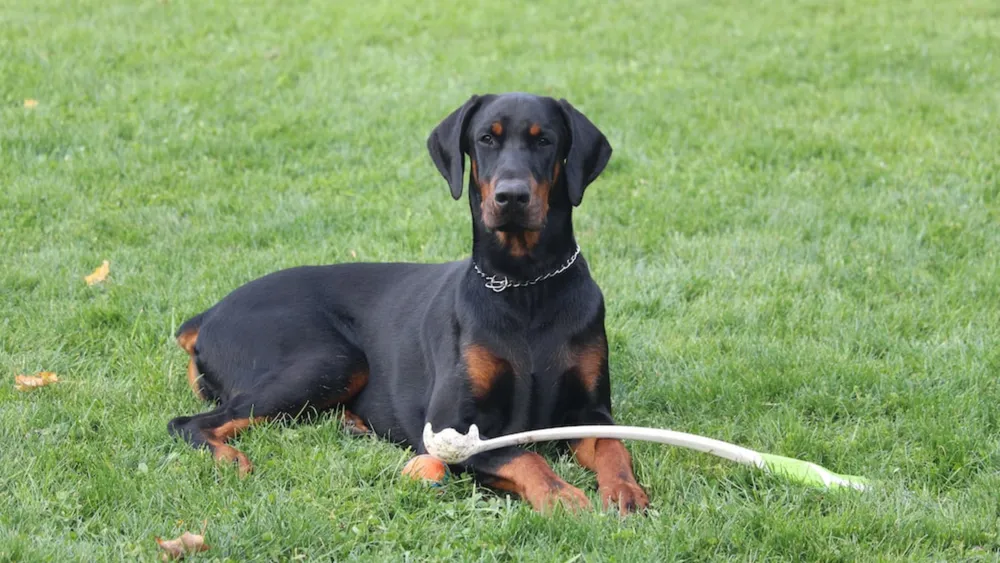This controversial practice has long been associated with the breed, stirring up debates among dog enthusiasts. While some argue that ear cropping is necessary for their aesthetics and historical purposes, others see it as unnecessary and inhumane. In this article, we will delve into the topic and explore the reasons behind ear cropping, its legality, and the potential implications for Doberman Pinschers.

History and Purpose of Ear Cropping:
The history of ear cropping can be traced back to ancient times when it was believed to have practical benefits. One of the main reasons for ear cropping among Doberman Pinschers was to enhance their hearing abilities. It was thought that by eliminating the floppy part of their ears, sound could reach their eardrums more effectively.
Additionally, cropped ears were seen as a way to protect the dog's ears from injuries during hunts or fights. However, as time went on, the reasons for ear cropping shifted. Nowadays, it is largely driven by personal preference and breed standards set by kennel clubs.
Some owners find the look of cropped ears more aesthetically pleasing and believe it adds to the breed's distinctive appearance. Breed standards established by kennel clubs often require Doberman Pinschers to have cropped ears to meet show requirements.
Pros and Cons of Ear Cropping:
Like any controversial practice, ear cropping comes with its own set of pros and cons. Proponents of ear cropping argue that it enhances the dog's appearance and gives them a more alert and imposing look. They believe that cropped ears are essential for maintaining the breed's identity and meeting the standards set by kennel clubs.
Additionally, some claim that cropped ears may reduce the risk of ear infections and other ear-related issues. On the other hand, opponents of ear cropping argue that it is purely cosmetic and serves no real benefit to the dog. They argue that cropping ears is a painful and unnecessary procedure that can lead to complications such as infection, excessive bleeding, and even changes in the dog's behavior. Furthermore, opponents believe that a dog's natural appearance should be embraced and altering it for aesthetic purposes is unethical.

Legal and Ethical Considerations:
The legality of ear cropping varies from country to country. In some places, ear cropping is illegal and considered an act of animal cruelty. These countries argue that the procedure is unnecessary and causes unnecessary pain and suffering to the dog. However, in other countries, ear cropping is still legal but regulated. It is often allowed only when performed by licensed veterinarians and under specific circumstances.
From an ethical standpoint, the debate surrounding ear cropping revolves around the concept of animal welfare. Opponents argue that altering a dog's appearance for cosmetic purposes goes against the principle of treating animals with respect and compassion. They believe that dogs should be allowed to have their natural appearance and that altering it solely for human preferences is unethical.
Proponents, on the other hand, argue that as long as the procedure is performed by professionals and the dog is given proper care, it is not unethical.
The Procedure of Ear Cropping:
The procedure of ear cropping involves surgically removing a portion of the Doberman Pinscher's ear to achieve the desired appearance. It is typically performed when the puppy is around 8 to 12 weeks old. The process itself can be quite invasive and requires general anesthesia. The ears are carefully shaped and sutured to promote the healing process and ensure the desired look is achieved.
While the procedure is performed under anesthesia, there are risks involved, including infection, excessive bleeding, and reactions to anesthesia. After the surgery, the dog will require close monitoring and proper aftercare to ensure a healthy recovery.

Aftercare for Cropped Ears:
After undergoing ear cropping surgery, Doberman Pinschers require diligent aftercare to ensure proper healing and minimize complications. This includes regular cleaning of the ears to prevent infections and removing any accumulated debris.
Also, it is important to monitor the dog for signs of pain or discomfort and provide appropriate pain management medication if necessary. It is crucial to follow the veterinarian's instructions regarding aftercare, including any prescribed medications, follow-up appointments, and restrictions on activities. Proper aftercare plays a vital role in the dog's recovery and overall well-being.
Alternative Options for Ear Appearance:
For those who are against ear cropping but still wish to alter the appearance of their Doberman Pinscher's ears, there are alternative options available. One popular method is ear taping, which involves using medical tape or splints to encourage the natural cartilage of the ears to stand upright.
This process requires patience and consistency but can result in a natural-looking upright ear position without the need for surgery. Another option is using ear braces or supports that are specifically designed to help the ears stand erect. These devices are non-invasive and can provide support to the ear cartilage, allowing the ears to achieve a desired appearance without the need for surgery.

Opinions and Controversies Surrounding Ear Cropping:
The debate surrounding ear cropping is highly polarized, with strong opinions on both sides. Those in favor argue that ear cropping is a personal choice and should not be judged by others. They believe that it is an integral part of the breed's heritage and aesthetics. On the other hand, opponents argue that ear cropping is unnecessary and inhumane, advocating for the preservation of a dog's natural appearance.
It is important to note that public opinion on ear cropping is shifting. Many countries and kennel clubs are reevaluating their stance on the practice, considering the ethical implications and the welfare of the dogs. As the discussion continues, it is crucial to consider all perspectives and gather information from reliable sources to make an informed decision.
Doberman Pinscher Breed Standards and Ear Cropping:
In the world of dog shows and competitions, breed standards play a significant role in determining the appearance of a particular breed. The American Kennel Club (AKC) and other kennel clubs have historically required Doberman Pinschers to have cropped ears to adhere to the breed standard. This has influenced the widespread practice of ear cropping among Doberman Pinscher owners.
However, there has been a shift in recent years, with some kennel clubs revising their breed standards to allow Doberman Pinschers with both cropped and natural ears to compete. This change reflects the evolving attitudes towards ear cropping and the recognition that a dog's appearance should not be the sole determining factor of their worth.

Conclusion:
The topic of Doberman Pinscher ear cropping is complex and highly debated. While there are historical justifications and breed standards associated with the practice, it remains a controversial topic. The decision to crop a Doberman Pinscher's ears should be carefully considered, taking into account the potential health risks, legal and ethical considerations, and the dog's overall well-being.
As public opinion on ear cropping continues to evolve, it is important to stay informed and engage in open discussions about the topic. Ultimately, the well-being of our furry companions should be at the forefront of any decision we make regarding their appearance and care.
FAQs
- Why are Doberman Pinscher ears historically cropped?
- Historically, ear cropping was done for Doberman Pinschers to enhance their appearance, provide a more alert appearance, and potentially prevent injuries while working.
- Is ear cropping still common for Doberman Pinschers?
- Ear cropping has declined in popularity due to ethical concerns and changing perceptions. Some countries have banned or strongly discourage this practice.
- What is the purpose of ear cropping for Doberman Pinschers?
- Ear cropping was believed to help improve their hearing ability, reduce the chances of ear infections, and give them a more intimidating look.
- Does ear cropping impact a Doberman's health or behavior?
- Ear cropping, when done improperly, can lead to complications such as infections and affect a dog's behavior due to pain and discomfort during the healing process.
- Are there alternatives to ear cropping for Doberman Pinschers?
- Natural, unaltered ears are increasingly preferred by owners. Regular ear care and grooming can help maintain a Doberman's ear health.
- When was ear cropping a common practice for Doberman Pinschers?
- Ear cropping became a standard practice for Doberman Pinschers in the late 1800s and early 1900s, originating from their working roles.
- Are there legal restrictions or regulations regarding ear cropping for Doberman Pinschers?
- Regulations vary by country and region. Some places have strict laws against cosmetic surgeries like ear cropping, while others allow it under specific circumstances or with veterinary supervision.